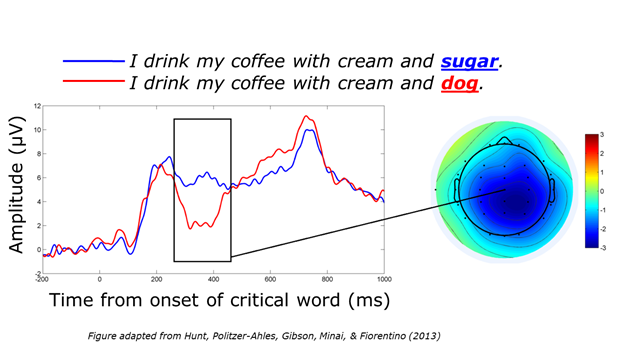
Imagine you record people's brain waves while they read two different kinds of sentences:
What do you think is the key difference between these sentences?
The word "sugar" fits in the context, is probably highly predicted/expected, and results in a reasonable, plausible sentence. On the other hand, the word "dog" doesn't fit the context, it's not expected, and it results in a weird sentence.
Words like this elicit different brain patterns, as you can see from the image below. Specifically, unexpected words that don't fit the context, like dog in this sentence, elicit a more negative brain wave around 400 milliseconds after the person sees or hears the word. This is called the N400 effect. ("N" for "negative", "400" for the fact that this wave usually occurs about 400 after seeing/hearing the stimulus.) For a detailed review of the N400 effect, see, e.g., Kutas & Federmeier (2011).

When the N400 was first discovered, many linguists were excited, because it seemed that this could be the brain activity pattern that reveals how the brain understands sentences. In other words, since this brain responses occurs when someone reads a weird sentence, this brain response must have something to do with how we put together sentences and how we realize if a sentence is weird or not. If we study this brain response more, maybe we could better understand how the brain comprehends sentences!
There was a problem, though. Some people pointed out that maybe the N400 is not related to sentence understanding at all.
Let's think about those sentences we saw before ("I drink my coffee with cream and sugar" vs. "I drink my coffee with cream and dog"). Here are a few more examples of the kinds of sentences that show N400 effects. In each example, the underlined word is the spot where the N400 difference (i.e., bigger N400 in the word that doesn't fit the sentence than in the word that does fit the sentence) appears.
| Plausible (less N400) | Implausible (more N400) |
| I drink my coffee with cream and sugar. | I drink my coffee with cream and dog. |
| He spread the bread with butter. | He spread the bread with socks. |
| They drank champagne to celebrate their twelfth wedding anniversary. | They drank champagne to celebrate their twelfth wedding flag. |
Now ignore the full sentences, and just focus on a few key words. Do you notice anything special?
Here are some of the key words from these sentences:
| Plausible (less N400) | Implausible (more N400) |
| cream ... sugar | cream ... dog |
| bread ... butter | bread ... socks |
| wedding ... anniversary | wedding ... flag |
If you've done the module about reaction times and priming, this pattern might look familiar: it looks like a priming experiment! In the plausible sentence, the critical word (the word where the N400 difference occurs) is related to other words in the sentence. In the implausible sentence, the key word is unrelated to the other words in the sentence.
Therefore, some people doubted that the N400 is related to sentence understanding. Maybe the N400 has nothing to do with sentences at all. Maybe the real story is just that when you see word that's unrelated to other words you recently saw (regardless of whether it's in a sentence or not), you get a big N400 effect—just like you would get slower reaction times in a priming experiment.
Which story is true? Does the N400 happen because of the overall meaning of a sentence (i.e., a person has an N400 effect when they read a sentence with a weird meaning, where a word doesn't fit the context)? Or does the N400 happen because of relationships between individual words (i.e., a person has an N400 effect when they read a word that's not related to the previous words)?
Many experiments have been done to test this question. Browse any one of the papers listed below to see how they tested this question, and what their answer does. Based on the paper you read, what do you conclude (i.e., do you think the N400 happens because of sentence meaning or because of word relationships) and what is your evidence for that conclusion (from the paper)?
When you have finished this activity, continue to the next section of the module: "How ERP components should and should not be understood".
by Stephen Politzer-Ahles. Last modified on 2021-05-05. CC-BY-4.0.